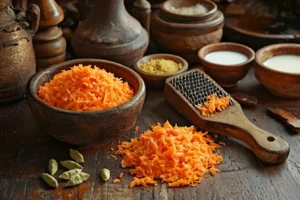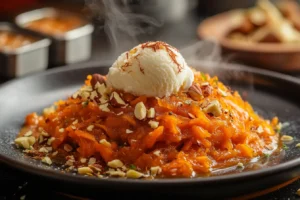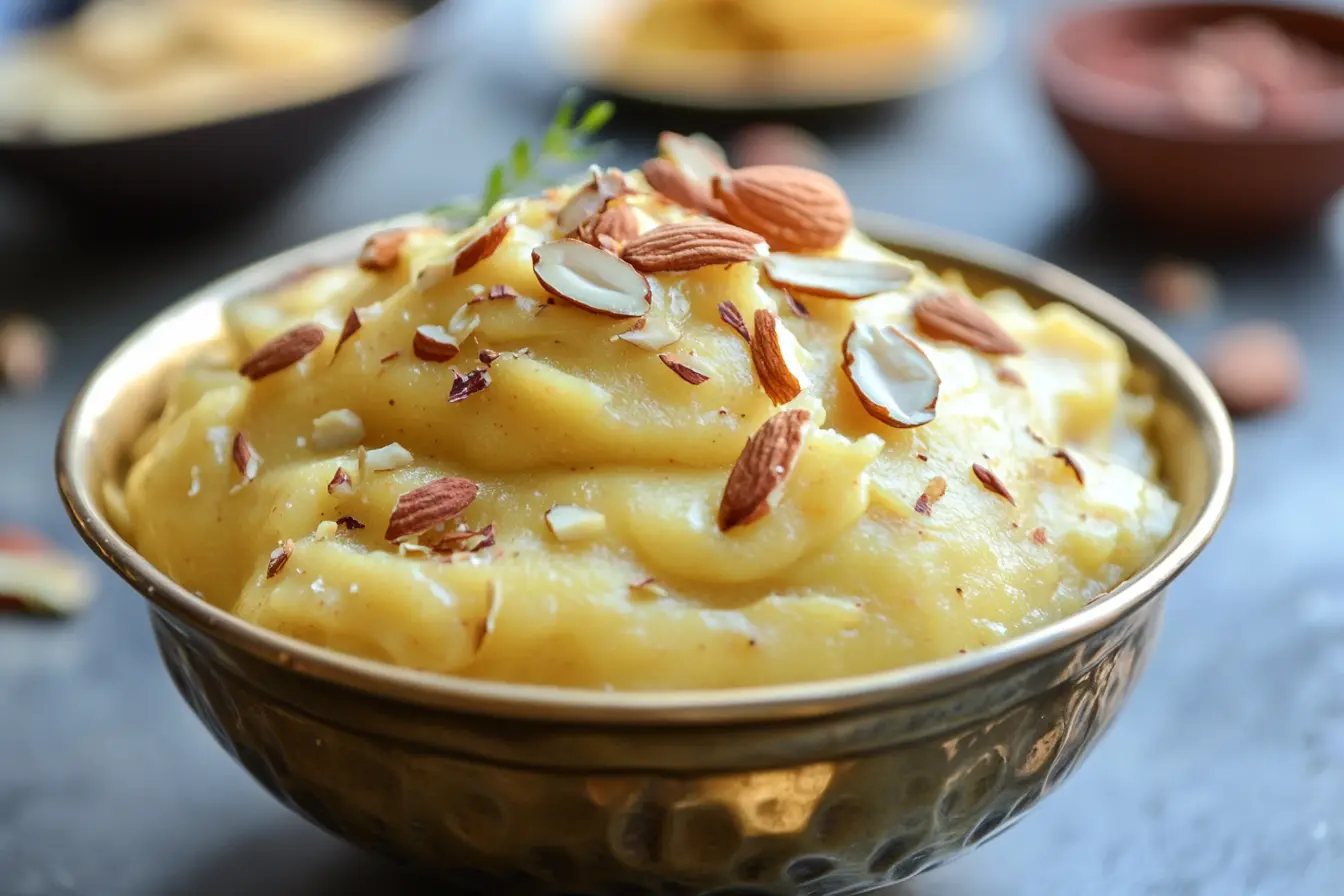Carrot Halwa, also known as Gajar ka Halwa, is a beloved Indian dessert that combines the natural sweetness of carrots with the richness of milk, ghee, and nuts. This dessert holds a special place in Indian cuisine, often gracing festival tables, family gatherings, and celebratory feasts. Simple to prepare yet decadent in taste, Carrot Halwa is not just a treat for the palate but also a journey into India’s vibrant culinary culture.
In this article, you’ll learn how to make the perfect Carrot Halwa Recipe with detailed steps, tips for the best results, and creative variations. Whether you’re a dessert enthusiast or a beginner looking to try your hand at Indian sweets, this guide has you covered! Let’s get started with Part 1: the introduction to this timeless dish.
Part 1: Introduction to Carrot Halwa Recipe
What is Carrot Halwa?
Carrot Halwa is a traditional Indian dessert crafted from grated carrots, milk, sugar, and ghee, often garnished with nuts, raisins, and a touch of cardamom. Known for its warm, comforting flavors, it’s enjoyed by people of all ages. This dish, often referred to as Gajar ka Halwa, is a winter favorite, thanks to the abundance of sweet, juicy carrots during the season.
Other Names for Carrot Halwa
Interestingly, this dish goes by several names, depending on the region. From Gajar ka Halwa in Hindi-speaking areas to Carrot Halwa among global enthusiasts, the essence remains the same—a luscious, carrot-based dessert that melts in your mouth.
Origin and Cultural Significance
Carrot Halwa has its roots in North India, where Mughal influences shaped its preparation. Over time, this recipe evolved into a household staple, symbolizing warmth, generosity, and the spirit of togetherness. During Indian festivals like Diwali or Holi, or even at weddings, serving a piping hot bowl of Carrot Halwa often signifies hospitality and celebration.
Why You’ll Love This Recipe
This recipe strikes the perfect balance between simplicity and indulgence. It’s beginner-friendly yet impressive enough for special occasions. Plus, it uses common pantry ingredients, making it accessible to everyone. Imagine the joy of a spoonful of warm, sweet, and nutty Gajar ka Halwa—a dessert that’s hard to resist!
Part 2: Ingredients for Perfect Carrot Halwa
Main Ingredients for Carrot Halwa Recipe
 To make the perfect Carrot Halwa, you’ll need just a handful of basic ingredients. However, it’s not just about what you use—it’s about how you combine them!
To make the perfect Carrot Halwa, you’ll need just a handful of basic ingredients. However, it’s not just about what you use—it’s about how you combine them!
- Fresh Carrots: The star of the dish! Choose bright orange, juicy carrots for the best results. Did you know that fresh carrots enhance both the texture and sweetness of the halwa?
- Milk: Full-fat milk works wonders for a creamy consistency, but you can substitute almond milk or oat milk for a dairy-free version.
- Sugar: White sugar is traditionally used, but jaggery or coconut sugar can be great alternatives if you’re looking for a healthier twist.
- Ghee: Ah, ghee—the golden elixir of Indian cooking! This clarified butter infuses the dish with a deep, rich flavor that no other fat can replicate.
Essential Flavor Enhancers
Although the base ingredients build the foundation of the halwa, the flavor enhancers truly elevate it.
- Cardamom Powder: Just a pinch of this aromatic spice brings warmth and depth to every bite.
- Nuts and Dry Fruits: Almonds, cashews, and raisins not only add a delightful crunch but also amplify the richness of the dessert.
Optional Additions for Unique Flavors
If you want to make your Carrot Halwa Recipe stand out, try adding these optional ingredients:
- Khoya (Reduced Milk Solids): This ingredient makes the halwa creamier, giving it a luxurious touch.
- Saffron Strands: Steeping a few strands in warm milk adds a burst of color and a hint of floral aroma to your halwa.
Tips for Choosing Quality Ingredients
First, always opt for seasonal carrots, as they’re naturally sweeter. Additionally, when buying ghee, look for pure, high-quality options to ensure the best flavor. And while you’re at it, don’t skimp on the nuts—they contribute both texture and nutrition!
Part 3: Step-by-Step Instructions: How to Make Carrot Halwa
Preparing for the Recipe
Before diving into the cooking process, preparation is key to ensuring everything goes smoothly. Start by gathering all your ingredients. This small step will save you time later and help you avoid last-minute scrambling.
- Wash and Peel the Carrots: Begin by thoroughly washing the carrots under running water. Use a vegetable peeler to remove the skin, which not only improves texture but also ensures a clean, vibrant appearance.
- Grate the Carrots: Grating is essential because finely shredded carrots cook faster and absorb flavors more effectively. You can use a hand grater for a more rustic texture or a food processor to save time.
Cooking the Carrot Halwa
Now that your ingredients are prepped, it’s time to cook! The magic happens in stages, so patience is your best friend.
- Step 1: Cook Carrots in Ghee
Heat a heavy-bottomed pan or kadhai over medium heat, and add two tablespoons of ghee. Once the ghee melts and releases its nutty aroma, toss in the grated carrots. Stir them gently to coat every shred with ghee. Allow the carrots to cook for 8–10 minutes, stirring occasionally to prevent sticking. - Step 2: Add Milk and Simmer
Pour in the milk and bring it to a gentle boil. Keep the heat low and let the mixture simmer, giving it a stir every few minutes. This process allows the carrots to soften while soaking up the creamy richness of the milk. Continue cooking until most of the milk evaporates, which usually takes 15–20 minutes. - Step 3: Sweeten the Mixture
Once the carrots are tender and the milk has reduced, add sugar. Stir it in thoroughly, and you’ll notice the halwa becoming glossy as the sugar dissolves. At this point, it’s crucial to stir continuously to prevent burning or sticking.
Final Touches
As the halwa thickens and reaches your desired consistency, it’s time to add the flavor enhancers. Sprinkle in cardamom powder for that signature aroma, then toss in chopped almonds, cashews, and raisins for a delightful crunch and a burst of sweetness.
Part 4: Tips and Variations for the Best Carrot Halwa
Expert Tips for a Perfect Carrot Halwa
 Achieving the perfect Carrot Halwa isn’t complicated, but a few expert tips can make all the difference. First, always use fresh, juicy carrots—this ensures the natural sweetness and texture shine through. Secondly, don’t rush the cooking process. Slow cooking allows the flavors to develop fully, so resist the urge to increase the heat.
Achieving the perfect Carrot Halwa isn’t complicated, but a few expert tips can make all the difference. First, always use fresh, juicy carrots—this ensures the natural sweetness and texture shine through. Secondly, don’t rush the cooking process. Slow cooking allows the flavors to develop fully, so resist the urge to increase the heat.
When adding sugar, remember that less is more. Start with a small amount and adjust as needed, especially since the sweetness of the carrots can vary. And here’s a golden rule: never skimp on ghee! Not only does it enhance the flavor, but it also keeps the halwa from becoming dry.
Creative Variations to Try
Although the classic recipe is delightful on its own, experimenting with variations can give your Carrot Halwa Recipe a unique twist.
- Vegan Carrot Halwa: Replace milk with almond or coconut milk, and use coconut oil instead of ghee. The result? A dairy-free version that’s equally creamy and flavorful.
- Low-Sugar or Sugar-Free Options: For a healthier alternative, substitute sugar with jaggery, stevia, or even date syrup. These natural sweeteners not only reduce calories but also add depth to the flavor.
- Fusion Recipes: Why stop at traditional halwa? Turn your creation into Carrot Halwa cupcakes, parfaits, or even a pie filling. It’s an exciting way to bring a modern twist to a classic dessert!
Troubleshooting Common Issues
Even experienced cooks sometimes run into challenges while making Carrot Halwa. For example, if your halwa turns out overly sweet, adding a splash of milk can help balance the flavor. If it becomes too dry, don’t panic—simply stir in a little extra ghee or milk to restore the creamy texture.
Part 5: Nutritional Information and Health Benefits
Nutritional Breakdown of Carrot Halwa
Carrot Halwa is more than just a delightful dessert; it’s also packed with nutrients that make it a somewhat guilt-free indulgence! A typical serving of Carrot Halwa contains around 150–200 calories, depending on the amount of sugar and ghee used.
When broken down, this dessert offers a balanced mix of macronutrients. Carrots contribute dietary fiber and natural sweetness, while milk provides calcium and protein. The ghee, though calorically dense, is a source of healthy fats that aid digestion and provide long-lasting energy. Nuts, which are often added as garnishes, bring a dose of protein, vitamins, and antioxidants to the dish.
Health Benefits of Key Ingredients
The ingredients in a Carrot Halwa Recipe aren’t just delicious—they also offer some impressive health benefits.
- Carrots: Rich in beta-carotene, carrots improve vision, boost immunity, and support healthy skin. Their high fiber content also aids digestion, making this dessert surprisingly wholesome.
- Ghee: This clarified butter is a powerhouse of fat-soluble vitamins like A, D, E, and K. Moreover, it promotes gut health and boosts metabolism when consumed in moderation.
- Milk: With its calcium and protein, milk strengthens bones and muscles, ensuring this dessert isn’t just tasty but also nourishing.
- Nuts and Raisins: Almonds and cashews bring heart-healthy fats, while raisins add a touch of natural sweetness along with iron and potassium.
Considerations for Diet Plans
Although Carrot Halwa can be enjoyed by almost everyone, a few modifications can make it fit specific dietary needs. For vegetarians, it’s naturally a go-to dessert since it doesn’t require eggs. For those on gluten-free diets, this dessert is a safe choice because none of the ingredients contain gluten.
If you’re watching your calorie intake, you can reduce the ghee and sugar or opt for plant-based milk and natural sweeteners. Diabetics might prefer using jaggery or stevia in place of sugar to lower the glycemic impact. However, as with any indulgent dish, portion control is essential to keep it healthy!
Part 6: FAQs About Carrot Halwa Recipe
Can I make Carrot Halwa without milk?
Yes, you absolutely can! If you’re aiming for a dairy-free version, substitute milk with almond, oat, or coconut milk. These alternatives not only maintain the creamy texture but also add subtle, nutty undertones to the flavor. Plus, they work beautifully if you’re catering to vegan guests or have lactose intolerance in the family.
How long can I store Carrot Halwa in the fridge?
Carrot Halwa can be refrigerated for up to a week if stored properly in an airtight container. To extend its shelf life even further, consider freezing it. Just ensure that the halwa cools completely before storing, as this prevents condensation and preserves its texture.
Can I use pre-grated carrots for the recipe?
While pre-grated carrots might seem like a time-saver, they often lack the juiciness and natural sweetness of freshly grated ones. However, if convenience is a priority, go for it—but choose high-quality, fresh pre-grated carrots for the best results.
What’s the best way to reheat Carrot Halwa?
Reheating is a breeze! Use a stovetop for even heating, as it helps maintain the dish’s original consistency. Alternatively, the microwave works well for smaller portions. Just add a splash of milk or ghee while reheating to revive the halwa’s rich texture and prevent dryness.
Is Carrot Halwa healthy for kids?
Absolutely! Packed with the goodness of carrots, milk, and nuts, this dessert provides essential nutrients like beta-carotene, calcium, and healthy fats. It’s a great way to introduce wholesome ingredients to picky eaters. Just remember to adjust the sugar for younger children to keep it healthier.
Can I use jaggery instead of sugar?
Yes, using jaggery is a fantastic idea! It not only reduces the refined sugar content but also adds a deep, caramel-like flavor to the halwa. When using jaggery, add it after the milk has reduced, as it can alter the texture if cooked too long.

